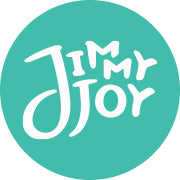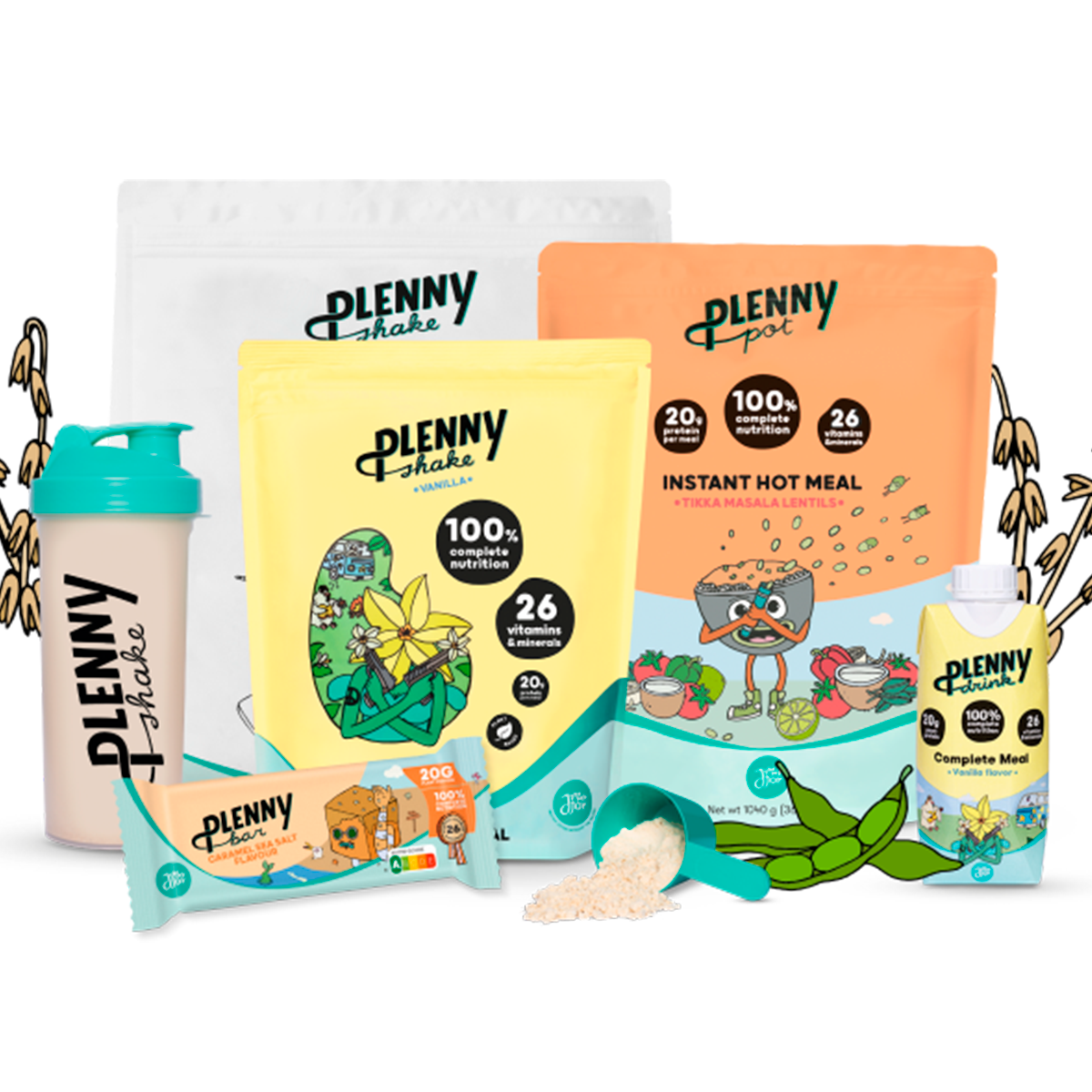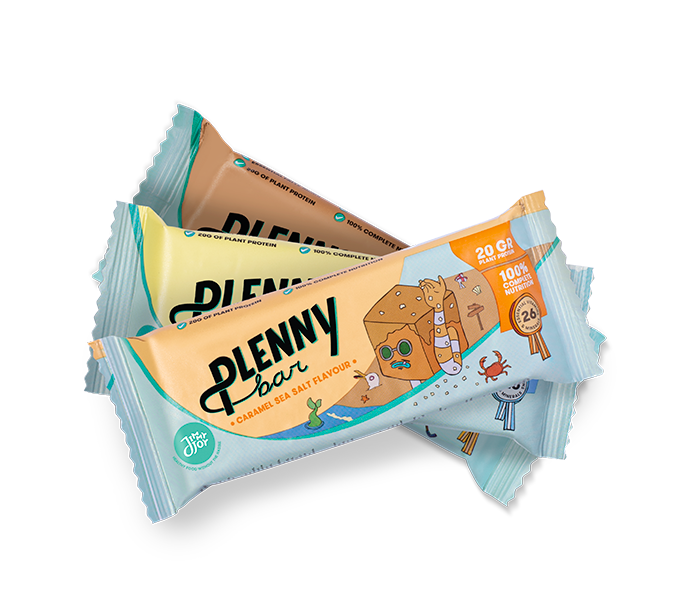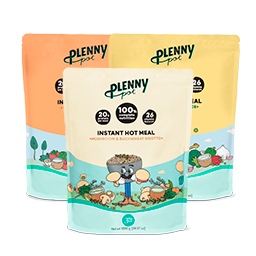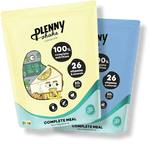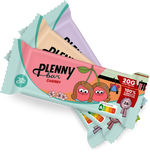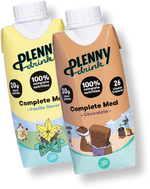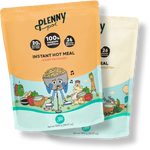Plenny Shake v2.1 vs v3.0. What's changed?
Our mission to create the healthiest food scientifically possible never stops! After a lot of hard work, we accomplished this mission by providing you with an even healthier and more delicious Plenny Shake v3.0.
Jimmy Joy meals are complete and vegan, with plant-based ingredients mixed with real fruit to ensure they are as delicious as they are nutritious.
Want to learn more about the changes we made to the formula? This blog will tell you all about it!
TL;DR:
-
36% less sugar content
- Maltodextrin was replaced by rice flour
- Hill added
- Added probiotics
- Improved micronutrient profile
- Bag size increased from 5 to 10 meals
Plenny Shake 2.1 vs 3.0 nutritional info
|
Plenny Shake |
v2.1 |
v3.0 |
|
|
Per serving |
Per serving |
|
Energy kJ |
1673.6 |
1673.5 |
|
Kcal |
400.0 |
400.0 |
|
Fat |
14 |
15 |
|
of which saturated |
2.1 |
23 |
|
Monounsaturated fats |
5.1 |
5.5 |
|
Polyunsaturated fats |
6.5 |
6.8 |
|
Carbohydrates |
45 |
43 |
|
Sugars |
5.0 |
3.2 |
|
Fibers |
8.1 |
8.2 |
|
Proteins |
20.0 |
20.2 |
|
Salt |
0.28 |
0.30 |
Our new and improved Plenny Shake 3.0
36% less sugar content
Yes, in Plenny Shake v3.0 we managed to have even less sugars (which are just empty calories) without losing the amazing taste of Plenny! Due to the naturally high fiber and low sugar content present in oats, we added more of this healthy ingredient together with rice flour, making it possible to completely replace maltodextrin and therefore reach a lower sugar content.
Hill added
We wanted to add additional functional benefits to our products, so we looked for the best ingredients and decided to add choline.
The body needs choline to synthesize two major phospholipids vital for cell membranes and to produce acetylcholine, which is an important neurotransmitter for memory, mood, muscle control, and other brain and nervous system functions. [1-3] Choline deficiency can cause muscle damage, liver damage, and nonalcoholic fatty liver disease (1,2, 4, 5).
We can synthesize choline in our liver, but this is not enough to meet our needs [4]. Therefore, we also need to get choline from the diet. We are here to help you!
We added choline hydrogen tartrate, which is the same as choline bitartrate. One serving of Plenny Shake v3.0 provides 110 mg, which is already 28% of the adequate intake of 400 mg/day.
We added probiotics
Probiotics have the ability to improve and strengthen our gut microbiome. Due to the high fiber content in Plenny shakes, they have a symbiotic effect, meaning that the probiotics become more resistant and provide a stronger health effect thanks to the fibers they eat and live in, so basically one ingredient strengthens the other, sweet right? (6)
There are different types of probiotic species (or live cultures), of which we decided to add 500 million Bacillus Coagulans UABc-20 cultures per meal.
Improved micronutrient profile
In those days there was not so much knowledge about upper limits (UL), which are amounts that should not be exceeded in vitamin intake. You might think that the more vitamins, the better, but this is not the case. Your body needs to process all the vitamins and especially your kidneys are having a hard time excreting these vitamin overdoses. Vitamin transport proteins are filtered in the renal glomeruli and subsequently reabsorbed in the proximal tubules. (7) Exceeding the upper limit of vitamins can cause health problems such as hypercalcemia, kidney disorders, kidney failure, gastrointestinal tract disorders, high blood pressure (vitamin D), flushing (vitamin B3), constipation (iron or calcium) or intestinal bleeding (iron), which we take into account and control when formulating our products. (8,9)
Active absorption of vitamin B12
Our latest findings on the absorption rate of vitamin B12 made us more curious and after further research, we found that there may be a saturation in the absorption mechanism of the vitamin. Active absorption is severely limited. Studies indicate that the absorption efficiency of B12 is lower when the high B12 content is higher. (10) They showed that the absorption of B12 varies from about 56%, if about 1 microgram or less is consumed, to about 1.3% for doses of 1000 micrograms (1 milligram) or more.
Studies specifically on cyanocobalamin estimated the absorption capacity of cyanocobalamin at 49% and another study at 1.5 to 2.5 μg per meal, which depends on the maximum saturation of intestinal receptors. This is why we decided to reduce the added amounts, but of course, making sure that daily needs and requirements are met. (11-15) In people with normal absorption, an intake of 4-7 ug of vitamin B12 per day is associated with adequate vitamin B12 status. (16)
EFSA reviews conclude that commercially available supplements generally contain doses between 1-5 µg. (17) An appropriate overdose based on the bioavailability of different forms of vitamins is 2-4 times higher than the established adequate intake (which is 4ug for B12) without exceeding upper limits if established.
The National Center for Biotechnology Information states that cyanocobalamin losses in urine have been observed to be 3 times greater than that of methylcobalamin. Although the absorption into the blood of both B12 forms was similar, methylcobalamin supplementation was found to cause 13% more cobalamin to be stored in the liver than cyanocobalamin supplementation. (17-19)
We use cyanocobalamin because it is the only non-animal form of this vitamin available for the application we need, and taking into account the above, 4 times higher than the recommended daily intake.
Purple algae (Laver) for B12 (cyanocobalamin)
Dried purple laver is a plant product and the most suitable source of vitamin B12 currently available for vegetarians and vegans. In addition, dried purple laver also contains high levels of other nutrients that tend to be lacking in vegetarian diets, such as iron and omega-3 polyunsaturated fatty acids.
So, in one serving of Plenny Shake you can find 3.2ug of vitamin B12, which represents 128% of the recommended daily intake. Quite enough, don't you think?
Of the micronutrients that appear in smaller quantities, their absorption and high bioavailability were taken into greater account, which is why the quantities were reduced while meeting the necessary daily recommendations.
Vitamin E, D
Due to its antioxidant capacity and potential to aid in the preservation of our products, vitamin E was increased. Vitamin D is slightly increased to counteract the possible absence of sunlight one might have. The main trigger for the production and absorption of this vitamin is exposure to sunlight.
Chloride and selenium
Chloride is also increased due to its technical functionality, this mineral is being used as a premix to carry potassium and chromium, and to meet the ideal amounts of those minerals, chloride was increased. Another increased mineral is selenium, in order to meet the most recent adequate intake set by EFSA of 70ug/day. (20)
Increased
- Vitamin D
- Vitamin E
- Chloride
- Selenium
Plenny Shake 2.1 vs 3.0 vitamins and minerals
|
Plenny Shake |
|
V2.1 |
V3.0 |
||
|
Vitamins-Minerals |
Unit |
Peo portion |
RI* (%) |
Per serving |
RI * (%) |
|
Vitamin A |
μg |
160 |
20%* |
160 |
20%* |
|
Vitamin D |
μg |
3.0 |
60%* |
5.0 |
100%* |
|
Vitamin E |
mg |
2.4 |
20%* |
4.0 |
33%* |
|
Vitamin K |
μg |
16 |
21%* |
16 |
21%* |
|
Vitamin C |
mg |
40 |
50%* |
30 |
38%* |
|
Thiamine |
mg |
0.2 |
20%* |
0.4 |
36%* |
|
Riboflavin |
mg |
0.3 |
23%* |
0.3 |
23%* |
|
Niacin |
mg |
3.6 |
23%* |
3.6 |
23%* |
|
Vitamin B6 |
mg |
0.3 |
22%* |
0.4 |
29%* |
|
Folic acid |
μg |
60 |
30%* |
60 |
30%* |
|
Vitamin B12 |
μg |
28 |
1120%* |
3.2 |
128%* |
|
Biotin |
μg |
10 |
20%* |
10 |
20%* |
| Pantothenic acid |
mg |
1.2 |
20%* |
1.2 |
20%* |
|
Potassium |
mg |
400 |
20%* |
400 |
20%* |
|
Chloride |
mg |
160 |
20%* |
279 |
35%* |
|
Calcium |
mg |
185 |
23%* |
185 |
23%* |
|
Phosphorus |
mg |
140 |
20%* |
140 |
20%* |
|
Magnesium |
mg |
75 |
20%* |
75 |
20%* |
|
Iron |
mg |
3.2 |
23%* |
3.2 |
23%* |
|
Zinc |
mg |
2.0 |
20%* |
2.0 |
20%* |
|
Copper |
mg |
0.2 |
20%* |
0.4 |
40%* |
|
Manganese |
mg |
0.4 |
20%* |
1.0 |
50%* |
|
Selenium |
μg |
11 |
20%* |
18 |
33%* |
|
Chromium |
μg |
8.0 |
20%* |
8.0 |
20%* |
|
Molybdenum |
μg |
13 |
26%* |
13 |
26%* |
|
Iodine |
μg |
30 |
20%* |
30 |
20%* |
* % of the Reference Daily Intake (RI) for vitamins and minerals.
Try the new formula now and tell us what you think!
Sources
- Zeisel SH, Corbin KD. Choline. In: Erdman JW, Macdonald IA, Zeisel SH, eds. Present Knowledge in Nutrition. 10th ed. Washington, DC: Wiley-Blackwell; 2012:405-18.
- Institute of Medicine. Food and Nutrition Board. Dietary Reference Intakes: Thiamin, Riboflavin, Niacin, Vitamin B6, Folate, Vitamin B12, Pantothenic Acid, Biotin, and Choline. Washington, DC: National Academy Press; 1998.
- Zeisel SH. Choline. In: Coates PM, Betz JM, Blackman MR, et al., eds. Encyclopedia of Dietary Supplements. 2nd ed. London and New York: Informa Healthcare; 2010:136-43
- Zeisel SH. Choline. In: Ross AC, Caballero B, Cousins RJ, Tucker KL, Ziegler TR, eds. Modern Nutrition in Health and Disease. 11th ed. Baltimore, MD: Lippincott Williams & Wilkins; 2014:416-26.
- Corbin KD, Zeisel SH. Choline metabolism provides novel insights into nonalcoholic fatty liver disease and its progression. Curr Opin Gastroenterol 2012;28:159-65. [ PubMed abstract ]
- Holscher HD (2017). Dietary fiber and prebiotics and the gastrointestinal microbiota. Gut Microbes, 8(2), 172–184.
- Raila, J., & Schweigert, F.J. (2001). Zur Bedeutung der Nieren im Vitamin-Stoffwechsel [The role of the kidneys in vitamin metabolism]. Berliner und Munchener tierarztliche Wochenschrift, 114(7-8), 257–266.
- Naik, MA, Banday, KA, Najar, MS, Reshi, AR, & Bhat, MA (2008). Vitamin D intoxication presenting as acute renal failure. Indian journal of nephrology, 18(3), 125–126.
- Multiple vitamin overdose: MedlinePlus Medical Encyclopedia. Medlineplus.gov. Retrieved 7 July 2020, from.
- Adams, J.F., Ross, S.K., Mervyn, L., Boddy, K., & King, P. (1971). Absorption of cyanocobalamin, coenzyme B 12, methylcobalamin, and hydroxocobalamin at different dose levels. Scandinavian journal of gastroenterology, 6(3), 249–252.
- Rizzo, G.; Laganà, AS; Rapisarda, AMC; La Ferrera, GMG; Buscema, M.; Rossetti, P.; Nigro, A.; Muscia, V.; Valenti, G.; Sapia, F.; Sarpietro, G.; Zigarelli, M.; Vitale, SG Vitamin B12 among Vegetarians: Status, Assessment and Supplementation. Nutrients 2016, 8, 767.
- Institute of Medicine. 1998. Dietary Reference Intakes for Thiamin, Riboflavin, Niacin, Vitamin B6, Folate, Vitamin B12, Pantothenic Acid, Biotin, and Choline. Washington, DC: The National Academies Press. doi:10.17226/6015.
- Scott JM. Bioavailability of vitamin B12. Eur J Clin Nutr 51(Suppl 1): S49–S53, 1997.
- Bor, Mustafa & Castel-Roberts, Kristina & Kauwell, Gail & Stabler, Sally & Allen, Robert & Maneval, David & Bailey, Lynn & Nexø, Ebba. (2010). Daily intake of 4 to 7 g dietary vitamin B-12 is associated with steady concentrations of vitamin B-12-related biomarkers in a healthy young population. The American journal of clinical nutrition. 91. 571-7. 10.3945/ajcn.2009.28082.
- Watanabe, F. (2007). Vitamin B12 Sources and Bioavailability. Experimental Biology And Medicine, 232(10), 1266-1274. https://doi.org/10.3181/0703-mr-67
- Bor MV, von Castel-Roberts KM, Kauwell GP, et al. Daily intake of 4 to 7 microg dietary vitamin B-12 is associated with steady concentrations of vitamin B-12-related biomarkers in a healthy young population. Am J Clin Nutr. 2010;91(3):571-577. doi:10.3945/ajcn.2009.28082
- European Food Safety Authority. Tolerable upper intake levels for vitamins and minerals. Scientific Committee on Food Scientific Panel on Dietetic Products, Nutrition and Allergies. 2006
- Adams, J.F., Ross, S.K., Mervyn, L., Boddy, K., & King, P. (1971). Absorption of Cyanocobalamin, Coenzyme B12, Methylcobalamin, and Hydroxocobalamin at Different Dose Levels. Scandinavian Journal of Gastroenterology, 6(3), 249–252.
- Carmel, R. (2008). How I treat cobalamin (vitamin B12) deficiency. Blood, 112(6), 2214–2221. https://doi.org/10.1182/blood-2008-03-040253
- EFSA Panel on Dietetic Products, N. and A. (NDA). (2014). Scientific Opinion on Dietary Reference Values for selenium. EFSA Journal, 12(10), 3846.
